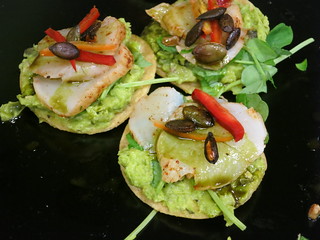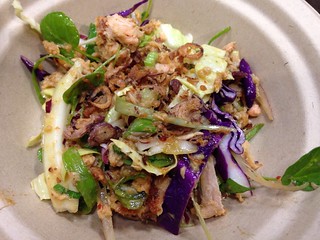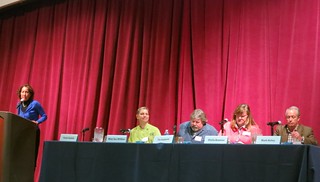Let's Talk About Sustainable Seafood
Last year I attended a Sustainable Seafood panel in LA presented by The Los Angeles Food Policy Council & Sustainable Seafood LA, and I learned a lot about seafood consumption in the US and the world.
Here are some facts about seafood you may not know:
Here are some facts about seafood you may not know:
- America is the 2nd largest consumer of seafood in the world (the first is China).
- We take half a billion pounds of seafood out of ocean each day.
- 90% of US seafood is imported.
- Shrimp is the #1 consumed seafood in US. Most of these are imported from Thailand. The 2nd most consumed is tuna. Pacific blue fin tuna, as you may already know, is depleted. But you can still eat skipjack tuna (which makes up 60% of canned tuna these days), albacore, and yellowfin.
- 50% of the world's seafood is from aquaculture (mostly from China).
- 70% of the fish in US is consumed in restaurants. That means chefs play a very important part in seafood sustainability!
- 2% of all research and development dollars go to USDA. Only 0.4% of that goes to aquaculture research.
Half the time at restaurants you won't get the fish you actually ordered. There's no law that requires restaurants to label their seafood. But we put our trust in the chefs, and a lot of the ones I know are good and will be do so, but maybe not at some other places. Like we've said, chefs play a very important part, as not only can they select seafood that is sustainable, but they can also introduce consumers to seafood that they would not normally eat. As Chef Mary Sue Milliken said on the panel, she's trying to figure out how to make sardines sexy! She and Chef Susan Feniger are long time proponents of sustainability. In fact, they pulled tuna off the menu 14 years ago after visiting Monterey Bay Aquarium and learning about what was happening to tuna population.
At the event itself, I tried a lot of delicious food made with sustainable seafood like sablefish from Morro Bay and more.
 |
| Alaskan scallop tiradito from Chef Milliken at Border Grill |
 |
| McFarland Springs trout salad from Chef Johnny Lee at Sticky Rice |
Now, let's talk about farmed fish.
Not all farmed fish is bad, but restaurants tend to stay away, but the reality is without farmed fish we will be out of fish in no time. There just isn't enough wild fish to go around with the amount we eat.. Part of the reason most farmed fish doesn't taste as good as wild fish. We must be more sophisticated in what diet to feed the fish. These days there are some great aqua farms, though, and some chefs are becoming more familiar and open minded to these.
Keep open mind, even farmed salmon now has new methods and improved practices, it just depends on the farm.





0 comments:
Post a Comment